
Introduction
Dell's UltraSharp range of screens has always been
popular and the 24" models have probably been at the fore front of this interest
ever since their 2405FPW screen was released in 2004 and was probably the first
"affordable" 24" model on the market. At the time, 17 and 19" screens were the
norm, and the 2405FPW was a massive screen upgrade. It's 1920 x 1200 resolution
and S-PVA panel were new and exciting and it seemed that screens would never
need to be any bigger. Of course things have changed in the last 10 years or so,
and 24" is pretty small by modern standard. Nevertheless the relatively low cost
and decent specs of 24" screens keep them popular with many buyers and Dell
continue to develop their 24" models every year.
In the 24" space, one debate which continues to
rage on is whether a 16:10 aspect ratio is better than a 16:9 aspect. 16:9 has
become increasingly popular as a 1920 x 1080 resolution is standard for a lot of
content nowadays. Panel manufacturers have invested more in 16:9 aspect ratio
panels, but there are still those out there who prefer the slightly bigger
(vertically) 16:10 1920 x 1200 resolution for office and general work.

Dell have offered 16:10 24" models since the
2405FPW was released, following it up with the 2407WFP,
2407WFP-HC,
2408WFP,
U2410,
U2412M and most recently the
U2413. There have been some fundamental changes in specs and positioning of
these models as well. If we focus on the most recent 16:10 aspect models you can
immediately spot some significant differences. The U2412M released in 2011 was
aimed at general multimedia and all-round uses. It had a standard gamut W-LED
backlight and 16.7m colour depth for instance and no fancy extra features beyond
Dell's normal decent range of ergonomic and connectivity options. The U2413 in
contrast, released a year later was aimed at semi-professional users primarily.
It had a wide colour gamut GB-r-LED backlight, 1.07b colour depth, hardware
calibration and uniformity compensation feature. It has a few other fancy extras
like a card reader, touch sensitive controls and PiP/PbP support. Two very
different screens really in specs and performance, and both still readily
available today as a result.
At the same time, Dell have started to introduce
some 16:9 models into their monitor range. In the 24" UltraSharp range
(well, 23.8", but near enough) is the
U2414H which was released at the beginning of 2014 and really impressed us
as an excellent all-round display with some noticeable improvements over the
U2412M, as long as you didn't specifically want the 16:10 aspect ratio of the
U2412M model. This year Dell have updated their 16:10 aspect ratio offering with
the newly released U2415. This screen is designed to be a replacement for the
aging U2412M screen, sticking with the standard gamut backlight and more general
features than the semi-professional grade U2413. As such, the U2413 will still
be available alongside the new U2415 if you specifically need some of the
advanced features offered there. Dell have however beefed up some of the extras
on the U2415 compared with the old U2412M. There's a factory calibration
provided, USB 3.0, MHL, new connectivity options, touch sensitive controls and a
new ultra-thin bezel design. We are keen to see if the U2415 can offer some of
the improvements that we saw from the U2414H model, but in a 16:10 aspect ratio
size.
If you appreciate the review
and enjoy reading and like our work, we would welcome a
donation
to the site to help us continue to make quality and detailed reviews for you.
|
Check Pricing and Buy - Direct Links
|
|
Amazon
|
|
TFTCentral is a participant
in the Amazon Services LLC Associates Programme, an affiliate
advertising programme designed to provide a means for sites to earn
advertising fees by advertising and linking to Amazon.com, Amazon.co.uk,
Amazon.de, Amazon.ca and other Amazon stores worldwide. We also
participate in a similar scheme for Overclockers.co.uk. |

Specifications and Features
The following table gives detailed information
about the specs of the screen:
|
Monitor
Specifications |
|
Size |
24.1"WS |
Panel Coating |
Light AG coating |
|
Aspect Ratio |
16:10 |
Interfaces |
1 DisplayPort (version 1.2)
|
|
Resolution |
1920 x 1200 |
|
Pixel Pitch |
0.27 mm |
Design
colour |
Thin black bezel, silver stand and base |
|
Response Time |
6ms G2G (Fast mode)
8ms G2G (Normal mode)
19ms ISO |
Ergonomics |
Tilt, 115mm height, swivel and rotate |
|
Static Contrast Ratio |
1000:1 |
|
Dynamic Contrast Ratio |
2 million:1 |
VESA Compatible |
Yes
100mm |
|
Brightness |
50 - 300 cd/m2 |
Accessories |
Power cable, cable cover, Mini DP to DP cable,
USB 3.0 cable, factory calibration report |
|
Viewing Angles |
178/178 |
|
Panel Technology |
LG.Display AH-IPS |
Weight |
With cables and stand: 6.69Kg |
|
Backlight Technology |
W-LED |
Physical Dimensions |
(WxHxD) with stand max height
532.2 x 517.9 x 205.0 mm |
|
Colour Depth |
16.78m |
|
Refresh Rate |
60Hz |
Special
Features |
5
port USB 3.0 hub (1 with battery charging), factory calibration and report,
audio out connection |
|
Colour Gamut |
Standard gamut ~99% sRGB |
The U2415 offers a good range of modern connectivity options. There are
2x HDMI (with MHL), 1x DisplayPort and 1x Mini DisplayPort input interfaces provided for video
connections. There is also a DisplayPort out connection for daisy chaining
several screens. There is no DVI or D-sub offered here which might be a bit of a
pain for older systems and graphics cards. Although a DVI > HDMI cable would be
an easy option if you've only got DVI output and no DisplayPort or HDMI. Cables
are provided in the box for only DP > Mini DP.
The screen has an internal power supply so there
is only the need for a kettle lead power cable (provided). There are several additional
features as well for this screen. These include a factory calibration, 5x USB 3.0 ports
(1 with battery charging support) and an audio out port.
Below is a summary of the features and connections
of the screen:
|
Feature |
Yes / No |
Feature |
Yes / No |
|
Tilt adjust |
 |
DVI |
 |
|
Height adjust |
 |
HDMI |
 |
|
Swivel adjust |
 |
D-sub |
 |
|
Rotate adjust |
 |
DisplayPort |
 |
|
VESA compliant |
 |
Component |
 |
|
USB 2.0 Ports |
 |
Composite |
 |
|
USB 3.0 Ports |
 |
Audio connection |
 |
|
Card Reader |
 |
HDCP Support |
 |
|
Ambient Light Sensor |
 |
MHL Support |
 |
|
Human Motion Sensor |
 |
Integrated Speakers |
 |
|
Touch Screen |
 |
PiP / PbP |
 |
|
Hardware calibration |
 |
Blur Reduction Mode |
 |
|
Uniformity correction |
 |
G-Sync |
 |

Design and Ergonomics
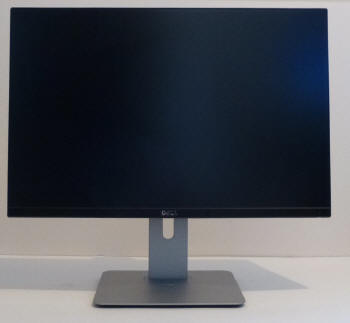
Above: front view of the screen. Click for larger version
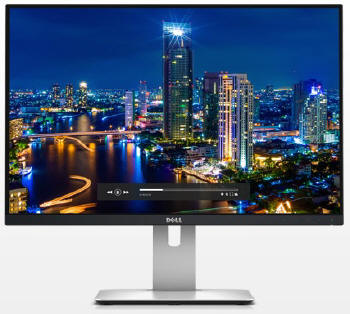
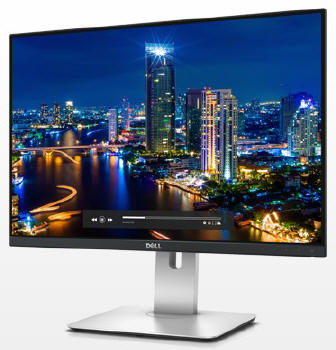
Above: front views of the screen. Click for larger versions
The U2415 comes in a black and silver
design. The front bezel of the screen is a matte black plastic and
provides a very thin outer edge to the screen. The actual plastic measures
only 1mm along the sides and top, and the bottom bezel is a modest 15mm as
well. Before people get too excited about the 1mm outer bezel, there is
also a ~5.9mm wide "inner bezel" to the panel before the actual image starts.
All in all, it's still only a 6.9mm edge (specified by Dell in fact)
around the image which looks very nice in practice and should be very good
for multi-screen setups. Note this is ever so slightly wider than the
U2414H (6.05mm outer edge).

There is a shiny silver Dell logo in the
middle of the bottom bezel, but not other writing or model designations at
all. In the bottom right hand corner are the four touch-sensitive OSD
control buttons and also a touch-sensitive power on/off button. There is a
small LED light underneath the power button which glows white during
normal operation and pulsates on/off white when the screen is on standby. Unlike some of the other UltraSharp screens we've seen
the OSD control buttons don't light up at all on the front of the bezel to
identify themselves, so you have to actually press the small grey circle
to operate the control.
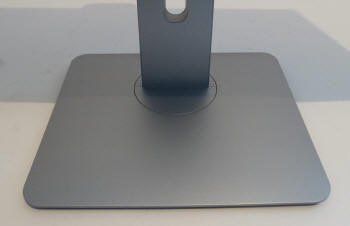
Above: view
of the stand and base. Click for larger version
The stand is different to the mostly black
style stands of some older UltraSharp models, and comes in an all-silver colour.
Matte plastics are again used for the stand and base. The base measures
~245 (width) x 205 mm (depth) and provides a sturdy support for the
screen. From the side the screen offers a pretty
thin profile thanks to the use of W-LED backlighting. The
stand is silver in design along the edges and back as well.

Above: rear
view of the screen and stand
The back of the screen is finished in a
matte black plastic and is rounded off to look smooth and sleek. There is
a useful cable tidy hole in the back of the stand. There is even a
detachable black plastic section at the bottom of the back of the screen
which can hide the cabling connections (pictured attached here). You will
notice the single USB 3.0 port on the back as well (right hand side in
above image) which also has charging capabilities. Useful to have one
easier access port offered here.

The screen provides a full range of
ergonomic adjustments from the stand which is good to see. It can also be
easily detached so you can wall or arm-mount the screen (VESA 100mm).
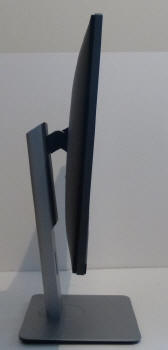
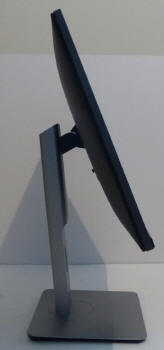
Above: full
range of tilt adjustment shown. Click for larger versions
The tilt function is smooth but a little
stiff to move, but it does offer a wide range of angles to choose.
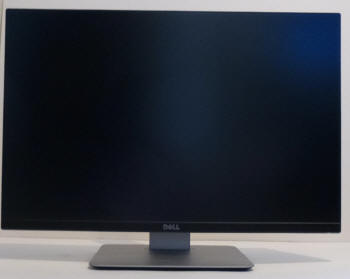
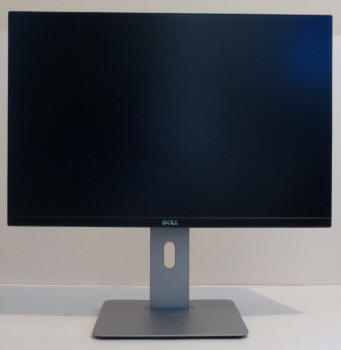
Above: full
range of height adjustment shown. Click for larger versions
Height adjustment is a little stiffer in the
downwards movement, but
is again smooth and easy to manoeuvre, offering a very good range of
adjustment again. At the lowest height setting the bottom edge of the
screen is approximately 45mm from the edge of the desk. At the maximum
setting it is ~165mm, and so there is a 120 mm total adjustment range
available here.
Side to side swivel is has a smooth movement
but it is extremely stiff to operate. If you try and swivel the screen
side to side without holding the base steady on the desk, the whole stand
will move. You need to hold the base really to re-position the swivel
adjustment on this model which is a bit of a shame.
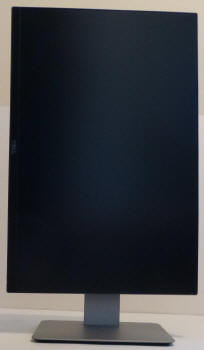
Above:
rotated view of the screen. Click for larger version
The rotate function is a bit stiff but smooth
enough to move if you want to switch into portrait mode. On a screen this size
it can actually be reasonably usable. Overall when making adjustments to your
viewing angle and position the screen remains stable on the desk and does not
wobble.
A summary of the screens ergonomic adjustments
is shown below:
|
Function |
Range |
Smoothness |
Ease of Use |
|
Tilt |
Yes |
Smooth |
A little stiff |
|
Height |
120mm |
Smooth |
Quite stiff |
|
Swivel |
Yes |
Smooth |
Very stiff |
|
Rotate |
Yes |
Quite Smooth |
Quite stiff |
|
Overall |
Good range of adjustments but
movements are a little stiffer than hoped, especially swivel |
The materials were of a good standard and the
build quality felt good as well. There was no audible noise from the screen,
even when conducting specific tests which can often identify buzzing issues.
The whole screen remained very cool even during prolonged use as well which
was pleasing.

Above:
rear views of the screen showing connections. Click for larger versions
The back of the screen provides connections for
the power cable which is provided with the screen. There are then
video connections for 2x HDMI, DisplayPort, Mini DisplayPort, DisplayPort out (for
daisy chaining), audio output, USB upstream and 4x USB 3.0
downstream. One USB connection is separated from the other three on the far
right hand side.
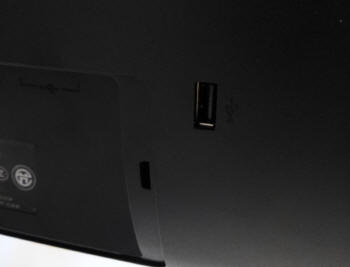
Above: view of
rear USB 3.0 connection on back of screen. Click for larger version
An additional easier access USB port is also
available a little above these connections in the back of the screen. It might
have been better to include this on the side of the screen perhaps for easier
access although the profile of the screen is very thin so this might not have
been possible.

OSD Menu
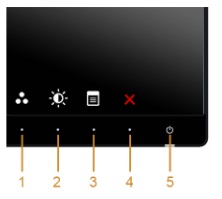
Above: OSD control buttons on the bottom right hand edge
The OSD menu is accessed and controlled through a
series of 5 touch-sensitive buttons located on the bottom right hand edge of the
bezel. There are small grey circles on the bezel marking where the buttons are
which are discrete. They don't light up at all, even when pressed. There is a
small power LED bar underneath the power button which glows white during use and
pulsates white on/off when the screen is on standby.
Pressing any of the buttons pops up the quick
access menu which is shown above. From here by default you have quick access to
the preset modes from button 1, input selection (actually shown as
brightness/control above) from button 2, the main menu (3) and a button to exit
(4). The power on/off button is shown as well, as button 5 above. You can
personalize the quick access options here through the main OSD if you want.
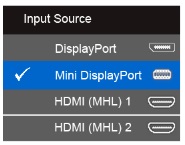
Using the quick access options pops up a smaller
menu above specific to that selection. For instance the input selection quick
access menu is shown above.
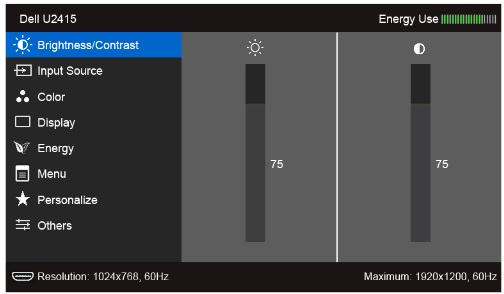
The main menu is split in to 8 sections shown down
the left hand side of the screen. The options available in each section are then
displayed on the right hand side. The first section is the brightness and
contrast menu which is self explanatory.
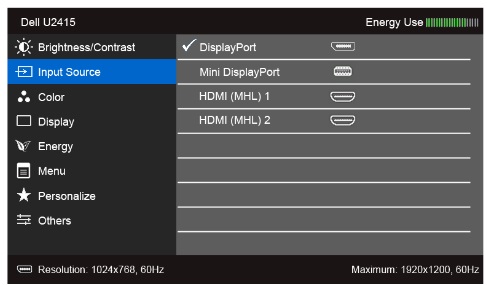
The second section allows you to change the input
being used.
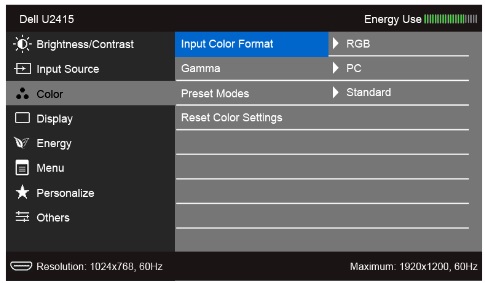
The 'color' menu gives you access to a few
options, mainly useful for accessing the preset mode menu. you can also enter
into the 'custom color' mode which then allows you to manually alter the RGB
channels for
calibration.
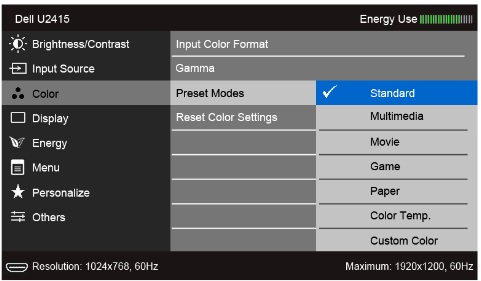
The preset mode menu is shown above and you can
see the 7 options available.
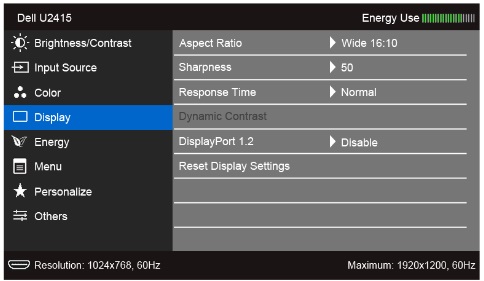
The 'Display' menu has a few useful extra
features. This includes the aspect ratio control menu (options for 16:10 wide,
4:3 and 5:4). You can also change the
response time
setting here.

The 'energy' section allows you to control the
power LED and USB ports.
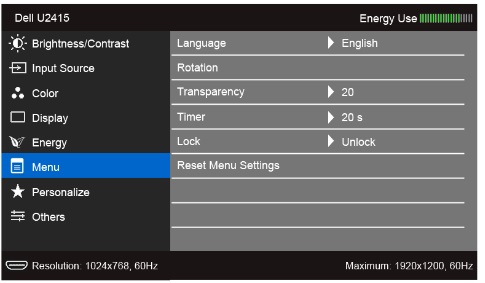
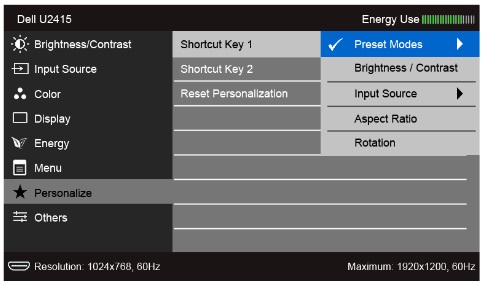
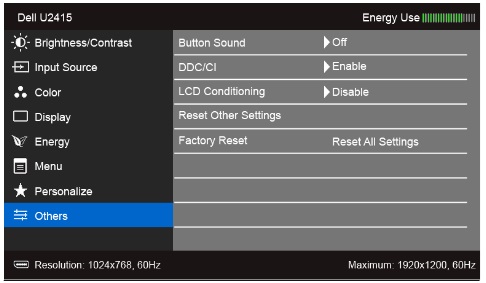
The other sections are self-explanatory really
from the pictures above.
All in all the menu was very easy to navigate and
well laid out. The control buttons were responsive and sensitive, and the
touch-sensitive nature gave them a premium feel. There were quite a few options
to play around with as well, and the ability to customise the quick access menu
was useful.

Power Consumption
In terms of power consumption the manufacturer
lists typical usage of 23.0W and less than 0.5W in standby. They also list
maximum power usage of 75.0W (*) but this is with maximum brightness, Dell
SoundBar and USB connected also. We carried out our normal tests to
establish its power consumption ourselves.
|
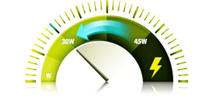 |
|
State and Brightness
Setting |
Manufacturer Spec (W) |
Measured Power Usage
(W) |
|
Default (75%) |
23.0 |
20.0 |
|
Calibrated (28%) |
- |
13.6 |
|
Maximum Brightness (100%) |
75.0 * |
24.2 |
|
Minimum Brightness (0%) |
- |
10.1 |
|
Standby |
<0.5 |
0.5 |
|
We tested this ourselves and found that out of the
box the screen used 20.0W at the default 75% brightness setting. Once calibrated the screen reached
13.6W consumption, and in standby it
used only 0.5W. We have plotted these results below compared with other screens
we have tested. The consumption is comparable actually to the other W-LED
backlit displays we have tested, with GB-r-LED backlit
displays (Dell U3014, U2713H, ViewSonic VP2772) using a bit more than most W-LED
backlights.
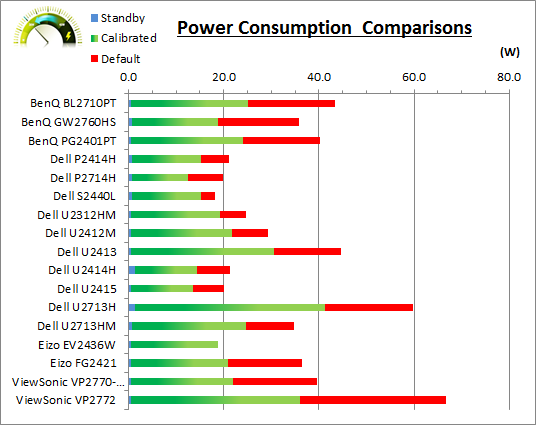

Panel and Backlighting
|
Panel Manufacturer |
LG.Display |
Colour Palette |
16.78 million |
|
Panel Technology |
AH-IPS |
Colour Depth |
? expected 6-bit + FRC |
|
Panel Module |
LM240WUA-SSA1 |
Colour space |
Standard gamut |
|
Backlighting Type |
W-LED |
Colour space coverage (%) |
99% sRGB, ~72% NTSC |
Panel Part and Colour Depth
The Dell U2415 utilises an
LG.Display LM240WUA-SSA1 AH-IPS panel which is capable of producing 16.78 million colours.
We have not been able to verify via the panel spec sheet as to whether this is a
true 8-bit module or a 6-bit+FRC panel, but we expect the latter given most of
the current standard gamut IPS panels used today are 6-bit+FRC, especially in
this size range. This is a
measure commonly taken on modern IPS panels, and the FRC algorithm is very well
implemented to the point that you'd be very hard pressed to tell any difference
in practice compared with an 8-bit panel. The panel is confirmed when
dismantling the screen
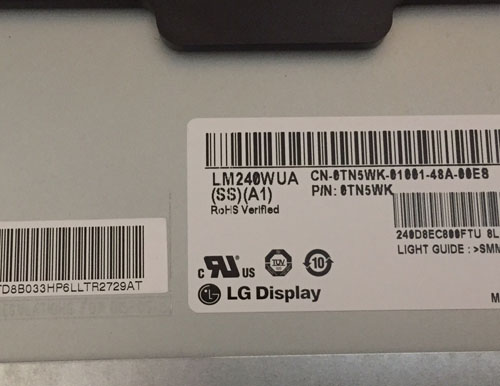
Screen
Coating
The
screen coating on the U2415 is a light anti-glare (AG) offering. It
isn't a semi-glossy coating, but it is light as seen on other modern IPS type panels
including the Dell U2414H for instance. Thankfully it
isn't a heavily grainy coating like some old IPS panels feature, including the
older U2412M model. It retains its anti-glare properties to
avoid too many unwanted reflections of a full glossy coating, but does not
produce an too grainy or dirty an image that some thicker AG coatings can. There
were no cross-hatching patterns visible on the coating.
Backlight Type and Colour Gamut
The screen uses a White-LED (W-LED) backlight unit
which has become very popular in today's market. This helps reduce power
consumption compared with older CCFL backlight units and brings about some
environmental benefits as well. The W-LED unit offers a standard colour gamut
which is approximately equal to the sRGB colour space (99% sRGB quoted).
Anyone wanting to work with wider colour spaces would need to consider wide
gamut CCFL screens or the newer range of GB-r-LED type displays available
now. If
you want to read more about colour spaces and gamut then please have a read of
our
detailed article.
Backlight
Dimming and Flicker
We tested the screen to establish the methods used
to control backlight dimming. Our in depth article talks in more details about a
common method used for this which is called
Pulse Width Modulation (PWM). This in itself gives cause for concern to some
users who have experienced eye strain, headaches and other symptoms as a result
of the flickering backlight caused by this technology. We use a photosensor +
oscilloscope system to measure backlight dimming control
with a high level of accuracy and ease. These tests allow us to establish
1) Whether PWM is being used to control the
backlight
2) The frequency and other characteristics at which this operates, if it is used
3) Whether a flicker may be introduced or potentially noticeable at certain
settings
If PWM is used for backlight dimming, the higher
the frequency, the less likely you are to see artefacts and flicker. The duty
cycle (the time for which the backlight is on) is also important and the shorter
the duty cycle, the more potential there is that you may see flicker. The other
factor which can influence flicker is the amplitude of the PWM, measuring the
difference in brightness output between the 'on' and 'off' states. Please
remember that not every user would notice a flicker from a backlight using PWM,
but it is something to be wary of. It is also a hard thing to quantify as it is
very subjective when talking about whether a user may or may not experience the
side effects.
100% 50%
0%
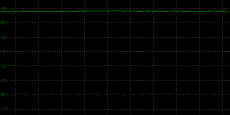
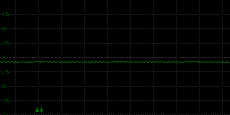
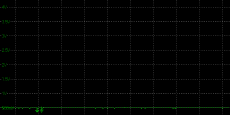
Above scale = 1
horizontal grid = 5ms
0% zoomed vertical
scale
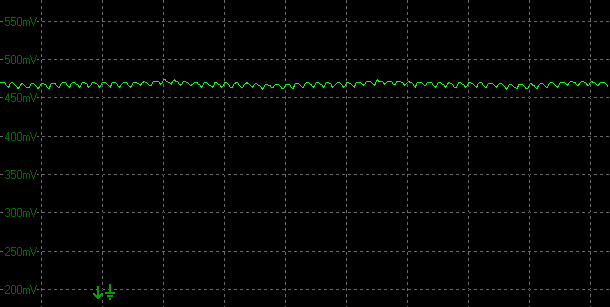
Above scale = 1
horizontal grid = 5ms
At 100% brightness a constant voltage is applied
to the backlight. As you reduce the brightness setting to dim the backlight a
very low amplitude slight oscillation is introduced but it is not a Pulse Width Modulation
switching. The amplitude of this oscillation is so low that you can only really
pick it up when changing the vertical scale down to 50 mV, as shown in the last
image zoomed in. It is operating also at a very high 1200 Hz frequency. We are
only including it here for completeness really, and this should not represent
any issue at all for any user. The screen can still be classified as flicker
free in our view, and PWM is not used for backlight dimming at any brightness
setting.
|
Pulse Width
Modulation Used |
No |
|
Cycling
Frequency |
1200 Hz very low amplitude oscillation |
|
Possible
Flicker at |
|
|
100% Brightness |
No |
|
50% Brightness |
No |
|
0% Brightness |
No |
For an up to date list of all flicker-free (PWM free) monitors please see our
Flicker Free Monitor Database.

Contrast
Stability and Brightness
We wanted to see how much variance there was in
the screens contrast as we adjusted the monitor setting for brightness.
In theory, brightness and contrast are two independent parameters, and good
contrast is a requirement regardless of the brightness adjustment.
Unfortunately, such is not always the case in practice. We recorded the
screens luminance and black depth at various OSD brightness settings, and
calculated the contrast ratio from there. Graphics card settings were left at
default with no ICC profile or calibration active. Tests were made using an
X-rite i1 Display Pro colorimeter. It should be noted that we used the
BasICColor calibration software here to record these, and so luminance at
default settings may vary a little from the LaCie Blue Eye Pro report.
|
OSD
Brightness |
Luminance
(cd/m2) |
Black
Point (cd/m2) |
Contrast
Ratio
( x:1) |
|
100 |
335.02 |
0.33 |
1015 |
|
90 |
285.75 |
0.28 |
1021 |
|
80 |
238.00 |
0.23 |
1035 |
|
70 |
202.52 |
0.20 |
1013 |
|
60 |
178.70 |
0.17 |
1051 |
|
50 |
155.53 |
0.15 |
1037 |
|
40 |
130.61 |
0.13 |
1005 |
|
30 |
105.14 |
0.10 |
1051 |
|
20 |
79.11 |
0.08 |
989 |
|
10 |
52.50 |
0.05 |
1050 |
|
0 |
26.82 |
0.03 |
894 |
|
Total Luminance Adjustment Range
(cd/m2) |
308.20 |
Brightness OSD setting controls backlight? |
 |
|
Total Black Point
Adjustment Range (cd/m2) |
0.30 |
|
Average Static Contrast Ratio |
1015:1 |
PWM Free? |
 |
|
Recommended OSD setting
for 120 cd/m2 |
36 |
The brightness control gave us a very good range
of adjustment. At the top end the maximum luminance reached 335
cd/m2 which was
high, and even a fair bit higher than the specified maximum brightness of 300 cd/m2
from the manufacturer. There was a decent 308 cd/m2 adjustment range
in total, and so at the minimum setting you could reach down to a low luminance
of 27 cd/m2. This was even lower than the advertised 50 cd/m2
from the manufacturer as well. This should be more than adequate for those
wanting to work in darkened room conditions with low ambient light. A setting of
36 in the OSD menu should return you a
luminance of around 120 cd/m2 at default settings.
It should be noted that the
brightness regulation is controlled without the need for
Pulse Width Modulation, using a Direct Current (DC) method for all brightness settings
between 100 and 0% and so the screen is flicker free.
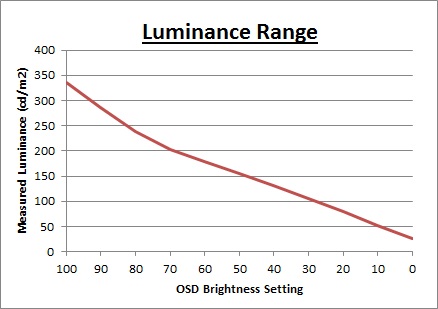
We have plotted the
luminance trend on the graph above. The screen behaves as it should in this
regard, with a reduction in the luminance output of the screen controlled by the
reduction in the OSD brightness setting. This is not a linear relationship as
the brightness adjustments between settings of 100 and 70 control a slightly
steeper luminance range.
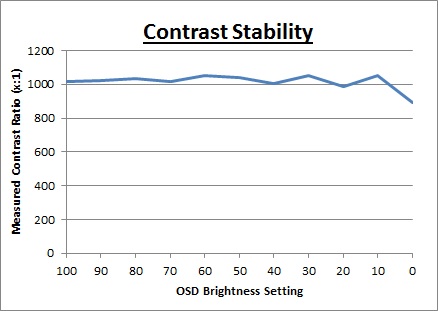
The average contrast ratio of
the screen was very good for an IPS panel with an average of 1015:1. This was
pretty stable across the brightness adjustment range as shown above although at
the lowest brightness settings it did fluctuate a little.

Testing
Methodology
An
important thing to consider for most users is how a screen will perform out of
the box and with some basic manual adjustments. Since most users won't have
access to hardware colorimeter tools, it is important to understand how the
screen is going to perform in terms of colour accuracy for the average user.
We restored our graphics card to default settings and disabled any previously active
ICC profiles and gamma corrections. The screen was tested at default factory settings using the DVI interface, and analysed using
an
X-rite i1
Pro Spectrophotometer (not to be confused with the i1 Display Pro
colorimeter) combined with
LaCie's Blue Eye Pro software suite. An X-rite i1 Display Pro colorimeter was
also used to verify the black point and contrast ratio since the i1 Pro
spectrophotometer is less
reliable at the darker end.
Targets for these tests are as follows:
-
CIE Diagram - validates the colour space
covered by the monitors backlighting in a 2D view, with the black triangle representing the
displays gamut, and other reference colour spaces shown for comparison
-
Gamma - we aim for 2.2 which is the default
for computer monitors
-
Colour temperature / white point - we aim
for 6500k which is the temperature of daylight
-
Luminance - we aim for 120
cd/m2, which is
the recommended luminance for LCD monitors in normal lighting conditions
-
Black depth - we aim
for as low as possible to maximise shadow detail and to offer us the best
contrast ratio
-
Contrast ratio - we aim
for as high as possible. Any dynamic contrast ratio controls are turned off here
if present
-
dE average / maximum -
as low as possible.
If DeltaE >3, the color displayed is significantly different from the
theoretical one, meaning that the difference will be perceptible to the
viewer.
If DeltaE <2, LaCie considers the calibration a success; there remains a
slight difference, but it is barely undetectable.
If DeltaE < 1, the color fidelity is excellent.

Default Performance and
Setup

The Dell U2415 comes factory calibrated, showing
their focus on providing a high quality product suitable for colour critical
work. This is similar to what they offer from the 16:9 format U2414H model as
well, although the measurement criteria is a little better here in fact. The screen is packaged with a calibration report
unique to your screen, confirming the targets set and met during that process.
Here they have factory calibrated the default 'Standard' preset mode to a 2.2 gamma, 6500k white point and with a
dE colour accuracy of <3 (the U2414H had dE <4 target). A copy of the calibration report from our unit is provided below for reference:
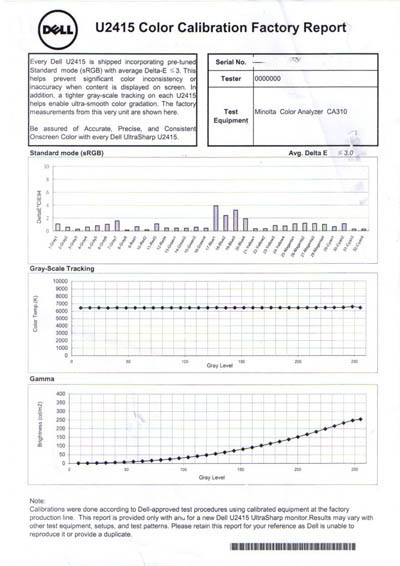
Default settings of the screen were as follows:
|
Monitor OSD Option |
Default Settings |
|
Brightness |
75 |
|
Contrast |
75 |
|
Preset mode |
Standard |
|
RGB |
n/a |

Dell U2415 - Default Settings / Factory Calibration




|
|
Default Settings |
|
luminance (cd/m2) |
218 |
|
Black Point (cd/m2) |
0.21 |
|
Contrast Ratio |
1017:1 |
Initially out of the box the screen was set in the
default 'standard' preset mode which carries the factory calibration discussed
above. The screen was bright as it was set at
a default 75% brightness setting. Colour balance felt
good, and you could tell it was a standard gamut screen. We went ahead and measured the default state with
the i1 Pro.
The
CIE diagram on the left of the image confirms that the monitors colour gamut
(black triangle) is roughly equal to
the sRGB colour space. There is some minor over-coverage in some red shades, and
some minor under-coverage in some green shades but not by anything significant.
Default gamma was recorded at 2.3 average, leaving it with a small 4% deviance
from the target of 2.2 which was reasonable. White point was measured at 6393k being close to the target of 6500k which was
very good and with
only a 2% deviance.
Luminance was recorded at a bright 218
cd/m2 which is
too high for prolonged general use. The screen was set at a default 75%
brightness in the OSD menu but that is easy to change of course to reach a more
comfortable setting without impacting any other aspect of the setup. The black depth was 0.21 cd/m2 at this default
brightness setting, giving us a very good (for a IPS panel) static contrast ratio of
1017:1.
Colour accuracy was pretty good out of the box
with a default dE average of 2.2, and maximum of 5.1. Testing the screen with
various gradients showed smooth transitions with no sign of any banding
thankfully. There was some slight gradation evident as you will see from most monitors
in darker tones.
Overall the default setup was good, with the gamma and white point being
very reasonable. Looks like the factory calibration does provide a reliable setup
for the screen which should be fine for most casual users.

Calibration
We used the
X-rite i1 Pro spectrophotometer combined with the LaCie Blue Eye Pro
software package to achieve these results and reports. An X-rite i1 Display Pro
colorimeter was used to validate the black depth and contrast
ratios due to lower end limitations of the i1 Pro device.
|
Monitor OSD Option |
Calibrated Settings |
|
Brightness |
28 |
|
Contrast |
75 |
|
Preset Mode |
Custom Color |
|
RGB |
100, 97, 97 |

Dell U2415 - Calibrated Settings
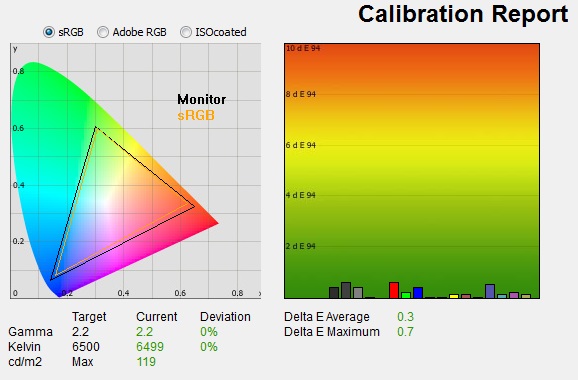
|
|
Calibrated Settings |
|
luminance (cd/m2) |
119 |
|
Black Point (cd/m2) |
0.12 |
|
Contrast Ratio |
1011:1 |
We changed to the 'custom color' preset mode first
of all which would give us access
to the RGB channels, as well as the brightness and contrast settings which are
available in all the modes. All these OSD
changes allowed us to obtain an
optimum hardware starting point and setup before software level changes would be
made at the graphics card level. We left the LaCie software to calibrate
to "max" brightness which would just retain the luminance of whatever brightness
we'd set the screen to, and would not in any way try and alter the luminance at
the graphics card level, which can reduce contrast ratio. These adjustments
before profiling the screen would help preserve tonal values and limit
banding issues. After this we let the software carry out the LUT adjustments and create an
ICC profile.
Average gamma was now corrected to 2.2 average,
correcting the 4% deviance we'd seen out of the box. The
white point was also corrected to the target, now measured at 6499k, correcting
the minor 2% deviance out of the box. Luminance had been improved thanks to the
adjustment to the brightness control and was now being measured at 119
cd/m2. This
left us a black depth of 0.12 cd/m2 and maintained a very good static contrast ratio
(for an IPS panel) of
1011:1. Colour accuracy of the resulting
profile was very good, with dE average of 0.3 and maximum of 0.7. LaCie would
consider colour fidelity to be very good overall.
Testing the screen with various colour gradients
showed mostly smooth transitions. There was some slight gradation in darker tones
but no banding introduced due to the adjustments to the
graphics card LUT from the profilation of the screen which was pleasing.
You can use our settings and
try our calibrated ICC profile if you wish, which are available in
our ICC profile database. Keep in mind that results will vary from one
screen to another and from one computer / graphics card to another.

Calibration
Performance Comparisons
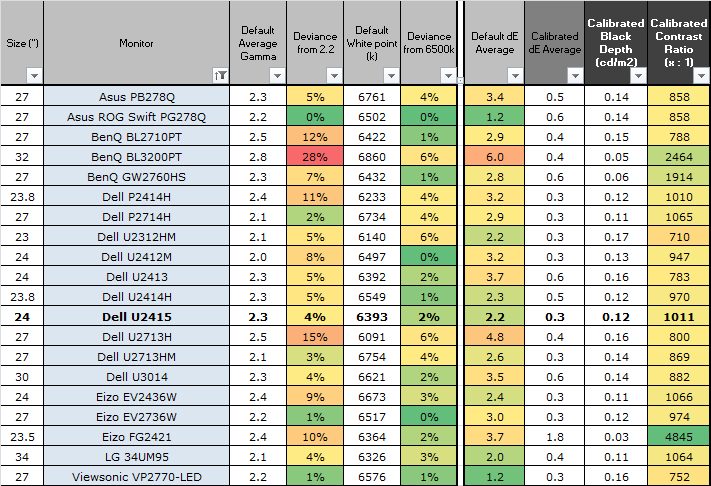
The comparisons made in this section try to give
you a better view of how each screen performs, particularly out of the box which
is what is going to matter to most consumers. When comparing the default factory
settings for each monitor it is important to take into account several
measurement areas - gamma, white point and colour accuracy. There's no point
having a low dE colour accuracy figure if the gamma curve is way off for
instance. A good factory calibration requires all 3 to be well set up. We have
deliberately not included luminance in this comparison since this is normally
far too high by default on every screen. However, that is very easily controlled
through the brightness setting (on most screens) and should not impact the other
areas being measured anyway. It is easy enough to obtain a suitable luminance
for your working conditions and individual preferences, but a reliable factory
setup in gamma, white point and colour accuracy is important and not as easy to
change accurately without a calibration tool.
From these comparisons we can also compare the
calibrated colour accuracy, black depth and contrast ratio. After a calibration
the gamma, white point and luminance should all be at their desired targets.
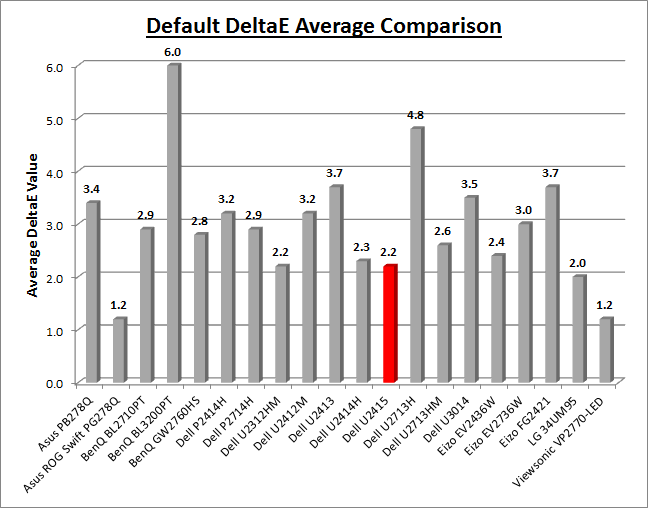
Default setup of the screen out of the box was
good with a gamma and white point within a few % deviance from the targets.
Colour accuracy was good at dE 2.2 average, and contrast ratio was strong for an
IPS panel at
over 1000:1. It
is too bright of course, but that's easy to turn down via the brightness
setting.
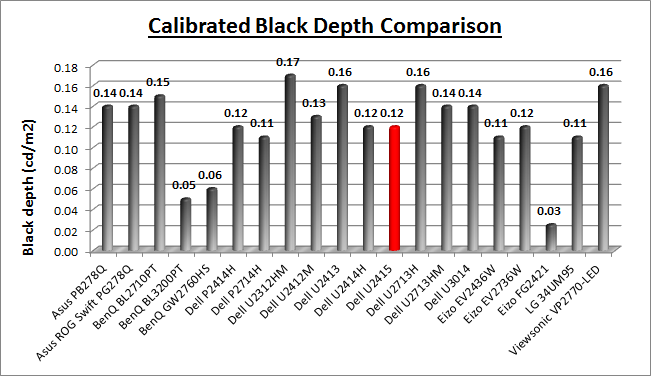
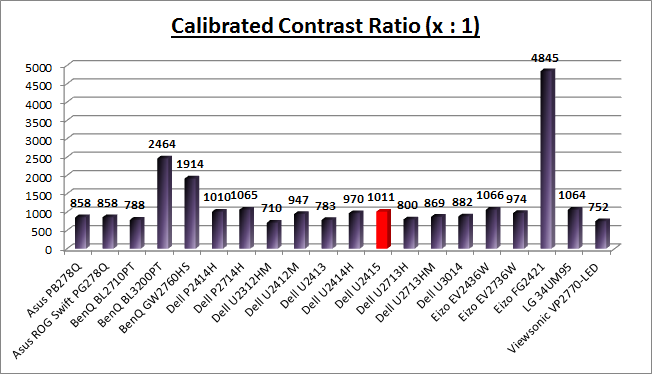
The display was strong when it came to black depth
and contrast ratio for an IPS-type panel. With a calibrated contrast ratio
of 1011:1 it was impressive for this technology. It can't compete with VA panel
types which can reach over 2000:1 easily, and commonly up to 3000:1, even close
to 5000:1 in the case of the
Eizo Foris FG2421.
|
Check Pricing and Buy - Direct Links
|
|
Amazon
|
|
TFTCentral is a participant
in the Amazon Services LLC Associates Programme, an affiliate
advertising programme designed to provide a means for sites to earn
advertising fees by advertising and linking to Amazon.com, Amazon.co.uk,
Amazon.de, Amazon.ca and other Amazon stores worldwide. We also
participate in a similar scheme for Overclockers.co.uk. |

Viewing Angles
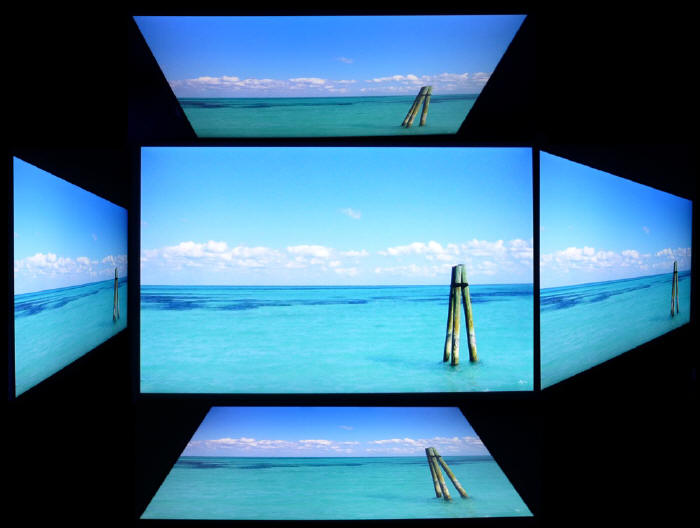
Above: Viewing
angles shown from front and side, and from above and below. Click for
larger image
Viewing angles of the U2415 were very good as you
would expect from an IPS panel. Horizontally there was very little colour tone
shift until wide angles past about 45°. A slight darkening of the image occurred
horizontally from wider angles as you can see above as the contrast shifted
slighting. Contrast shifts were slightly more noticeable in the vertical field
but overall they were very good. The screen offered the wide viewing angles of
IPS technology and was free from the restrictive fields of view of TN Film
panels, especially in the vertical plane. It was also free of the off-centre
contrast shift you see from VA panels and a lot of the quite obvious gamma and
colour tone shift you see from some of the modern AMVA and PVA offerings. All as
expected really from a modern IPS panel.
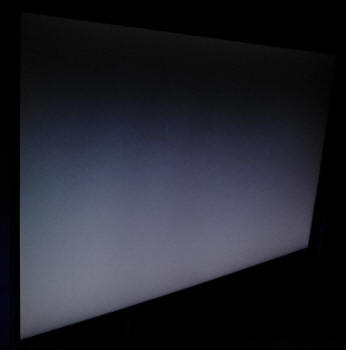
Above: View of an
all black screen from the side. Click for larger version
On a black image there is a characteristic white
glow when viewed from an angle, commonly referred to as IPS-glow. This is common
on most modern IPS panels and can be distracting to some users. If you view dark
content from a normal head-on viewing position, you can actually see this glow
as your eyes look towards the edges of the screen. This is not so much of a
problem on a smaller 24" screen than it might be on some of the larger displays
available today, but could still be distracting if you work with a lot of dark
content. The IPS-glow was more pronounced than we had seen from the
U2414H, but on the U2415 it was pretty standard for an IPS panel.

Panel Uniformity
We wanted to test
here how uniform the brightness and colour temperature was across the screen, as well as identify any
leakage from the backlight in dark lighting conditions. Measurements of the luminance
and colour temperature were taken at 35 points across the panel on a pure
white background. The measurements for luminance were taken using BasICColor's calibration
software package, combined with an X-rite i1 Display Pro
colorimeter with a central point on the screen calibrated to 120 cd/m2. Measurements for colour temperature (white point) were taken using
BasICColor software and the i1 Pro spectrophotometer which can more accurately
measure the white point of different backlighting technologies. The below uniformity diagram shows the difference, as a percentage,
between the measurement recorded at each point on the screen, as compared with the
central reference point.
It is worth
noting that panel uniformity can vary from one screen to another, and can depend
on manufacturing lines, screen transport and other local factors. This is only a
guide of the uniformity of the sample screen we have for review.

Uniformity of Luminance
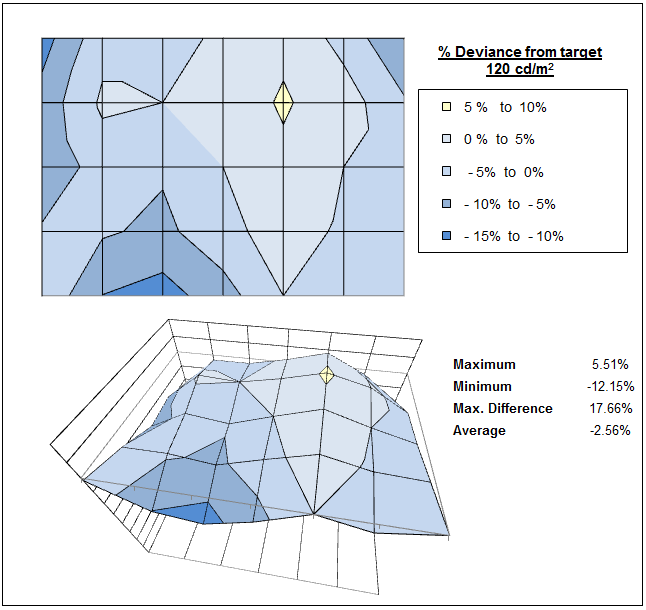
The luminance uniformity of the screen was
pretty good overall. The upper right hand
region seemed to be a little lighter than the lower left hand region, but
not by much. In the upper right hand area the luminance ranged up by 5.51%
(127
cd/m2
maximum) compared with the centrally calibrated 120 cd/m2 point.
Along the lower left hand edge the luminance reached down to 107 cd/m2
minimum (-12.15%). Overall around 90% of the screen remained within a 10%
deviance of the calibrated central point.

Backlight Leakage
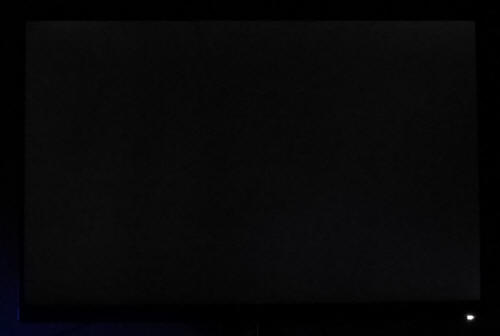
Above: All black screen in a darkened room. Click for larger version
As usual we also tested the screen with an all
black image and in a darkened room. A camera was used to capture the result. The
camera showed there was pretty much no backlight leakage here at all. A very
slight amount was detected along the upper left hand edge, but it was barely
noticeable at all. A pleasing result from the U2415 here.

General and Office Applications

The 1920 x 1200 resolution and 24.1" screen size
give a nice decent area in which to work and the vertical resolution is a little
more than the range of 16:9 aspect 24" models (1920 x 1080) out there in the
market. A lot of people prefer this extra vertical area and it is useful for
office applications we think. You may want to consider the fact that high
resolution 27" 2560 x 1440 models are becoming increasingly available and so the
difference in desktop size is certainly noticeable coming from a 27" screen like
that. Nevertheless, the 24" 1920 x 1200 resolution should be adequate for many
users. The screen offered a comfortable 0.27mm pixel pitch which delivered easy
to read text at a nice size, in our opinion. The resolution is big enough for
side by side split screen working as well in many cases although we do find that
nowadays a lot of web content needs more than half a screen (i.e. wider than 960
pixels).
The light AG coating of the new AH-IPS panel is
certainly welcome, and a very positive change from the older grainy and 'dirty'
appearance of older IPS AG coatings, including that used on the U2412M model.
The wide
viewing angles provided by the IPS panel technology on both horizontal and
vertical planes, helps minimize on-screen colour shift when viewed from
different angles.
The default setup of the screen was good in all
regards thanks to the pretty decent factory calibration, and we were also
pleased with the strong 1000:1+ contrast ratio.
The brightness
range of the screen was also very good, with the ability to offer a luminance
between 335 and 27 cd/m2. This should mean the screen is perfectly
useable in a wide variety of ambient light conditions, including darkened rooms.
A setting of ~36 in the OSD brightness control should return you a luminance
close to 120 cd/m2 out of the box. If you switch to the 'custom color'
mode and want to try our calibrated settings then the brightness setting is
detailed in that section of the review. On another positive note, the brightness
regulation is controlled without the need for the use of the now infamous
Pulse-Width Modulation (PWM), and so those who suffer from eye fatigue or
headaches associated with flickering backlights need not worry. The older U2412M
model did use PWM (as did nearly all screens for a long time), so this is
another significant change with the new model.
There was no
audible noise or buzzing from the screen, even when specifically looking for it
using test images with a large amount of text at once. The screen also remains
cool even during prolonged use. There is a 'paper' preset mode available from
the menu which may be useful if you want to set up the screen for different uses
perhaps and made the image more yellowy green. There are only 2x HDMI and 2x
DisplayPort connections (1 regular, 1 mini) here so connectivity could be
considered a little limited for some older systems. We would have liked to have
seen DVI and VGA provided as many graphics cards still rely on these options and
no one wants to have to go and fork out for an adapter cable really.
The screen offers 5x USB 3.0 ports which can be
useful and it was nice to keep this up to date with the modern version. The old
U2412M featured only 2x USB 2.0 ports so there is a nice upgrade here. On the
U2412M they were located on the side of the screen which is a little easier to
access than on the new U2415. Here, 4 of them are on the underside back with the
video connections, and 1 is on the back of the screen (the charging capable
port) since the profile of the screen is too thin to really make them easy to
include on the edge of the screen.
There are no further extras like ambient light
sensors or card readers which can be useful in office environments. There was a
great range of ergonomic adjustments available from the stand allowing you to
obtain a comfortable position for a wide variety of angles. The VESA mounting
support may also be useful to some people as well. Perhaps one of the biggest
draws for the U2415 is its ultra-thin bezel and narrow edges. This makes it
potentially a great screen for multi-monitor setups and we liked the design of
the new screen.
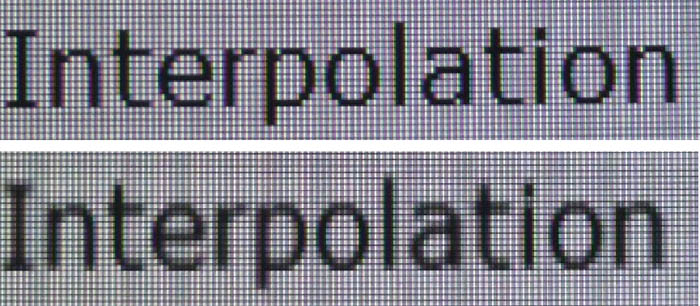
Above: photo of
text at 1920 x 1200 (top) and 1680 x 1050 (bottom)
The screen is designed to run at its native
resolution of 1920 x 1200 and at a 60Hz recommended refresh rate. However,
if you want you are able to run the screen outside of this resolution. We tested
the screen at a lower 1680 x 1050 resolution to see how the screen handles the
interpolation of the resolution, while maintaining the same aspect ratio of
16:10. At native resolution the text was very sharp and comfortable as we've already
discussed. When running at a 1680 x 1050 resolution the text is still pretty
sharp, with low levels of blurring. You do lose some screen real-estate as well
of course.

Responsiveness and Gaming
|
Quoted G2G Response Time |
6ms G2G (Fast mode)
8ms G2G (Normal mode) |
|
Quoted ISO Response Time |
19ms |
|
Panel Manufacturer and
Technology |
LG.Display |
|
Panel Part |
LM240WUA-SSA1 |
|
Overdrive Used |
Yes |
|
Overdrive Control Available to
User |
'Response Time' |
|
Overdrive Settings |
Normal, Fast |
The U2415 is rated by Dell as having a 6ms to 8ms G2G response time,
depending on the setting selected,
which indicates the panel uses
overdrive /
response time compensation (RTC) technology to boost pixel transitions
across grey to grey changes. There is user control over the overdrive impulse
within the OSD menu using the 'Response Time' option. The
part
being used is the
LG.Display LM240WUA-SSA1 AH-IPS panel. Have a read about response time in
our
specs section if you need additional information about this measurement.
We will first test the screen using our thorough
response time testing method. This uses an oscilloscope and photosensor to
measure the pixel response times across a series of different transitions, in
the full range from 0 (black) to 255 (white). This will give us a realistic view
of how the monitor performs in real life, as opposed to being reliant only on a
manufacturers spec. We can work out the response times for changing between many
different shades, calculate the maximum, minimum and average grey
to grey (G2G) response times, and provide an evaluation of any overshoot present
on the monitor.
We use an
ETC M526
oscilloscope for these measurements along with a custom photosensor device.
Have a read of
our response time measurement article for a full explanation of the testing methodology and reported
data.
Response Time Setting Comparison

The U2415 comes with a user control for the
overdrive impulse available within the OSD menu in the 'display' section as
shown above. This is rare for a Dell screen as normally you end up being reliant
on the factory setup and often this has lead to issues with overshoot on some
models (e.g. Dell U2413, U2713H, U3014). There are two options available here in
the menu, for 'normal' and 'fast' modes.
First of all we carried out a smaller sample set
of measurements in both of the 'Response Time' settings. These, along with various
motion tests allowed us to quickly identify which was the optimum overdrive setting
for this screen.

First we tested the screen with the Response Time
option set to 'Normal' which according to Dell should have an 8ms G2G response
time. Response times varied somewhat, with some transitions being a little
slower at around 11 - 12ms, and others reaching down to 5 - 6 ms. Overall we
measured an average 8.3ms G2G response time which was very good for an IPS-type
panel in fact. It was even a little faster than models like the Dell P2414H and
U2414H (8.9ms G2G average) which we take at the moment as a reference point for
IPS technology in terms of reaching the fastest response times without
introducing any significant overshoot. The U2415 was also pretty much free from
overshoot which was very pleasing, and so this could well be a new reference
point for us for IPS response times. Let's see if the 'Fast' mode can offer any
improvements at all.

With the Response Time setting now switched up to the 'Fast'
mode, response times had improved a little to 7.1ms G2G average, not quite as
fast as the 6ms G2G spec listed. However, this
was at the cost of some noticeable overshoot which was probably too high to make
it practical for most uses. The overdrive was being applied too aggressively
here, trying to reduce response times further, but introducing too many
side-effects sadly. The 'Normal' mode was optimum on this model.
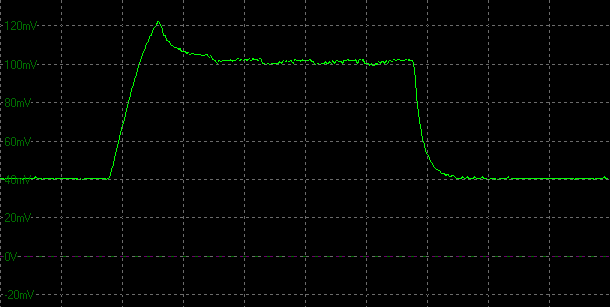
Transition: 0-50-0
(scale = 20ms)
The above graph gives an example of the overshoot
which manifests itself when you select the 'Fast' response time setting. On the
rise time in this example, the brightness overshoots the desired level here by 32.2% which is
noticeable to the user.

If we take some test photos using the PixPerAn
tool you can make some further visual comparisons between the overdrive
'Response Time' settings. With Response Time set to 'normal' the moving image
showed no noticeable ghosting and low levels of motion blur. There was no sign
of any overshoot artefacts either. When you switch to the 'fast' setting, the
blurring is reduced a little as response times are boosted. Some slight
overshoot is evident but nothing major in these specific tests. We know from our
oscilloscope measurements above that some transitions do show significant levels
of overshoot so we still prefer the 'normal' mode.
More Detailed Measurements - Response Time =
Normal
Having established that the Response Time 'Normal' mode seemed to
offer the best response/overshoot balance we carried
out our normal wider range of measurements as shown below:
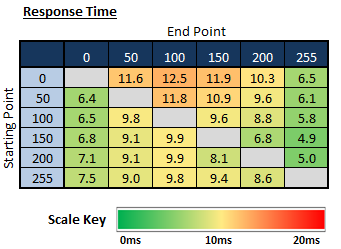
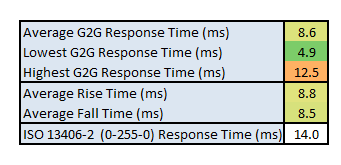
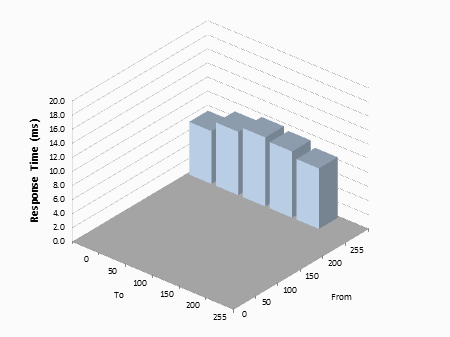
The average G2G response time was more accurately
measured at 8.6ms which was very good for an IPS panel overall. Some transitions
were faster at 4.6 - 6 ms minimum, particularly when changing to white (x >
255). The
rise and fall time average was very similar and so pixel transition times were
fairly consistent across the board.
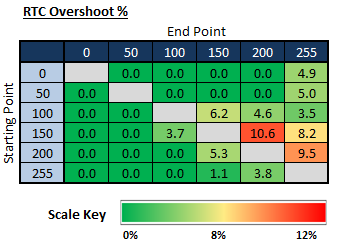
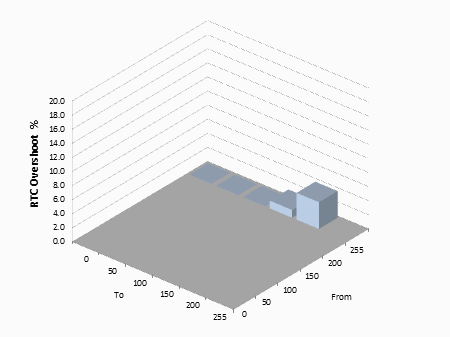
There was pretty much no overshoot as well in this
Response Time mode, with only a couple of transitions showing anything at all, and
even then, pretty low.
The overdrive impulse was being applied well and in a controlled fashion which was pleasing.

Display Comparisons
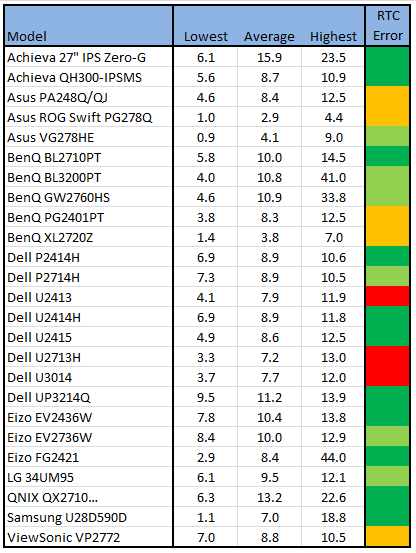
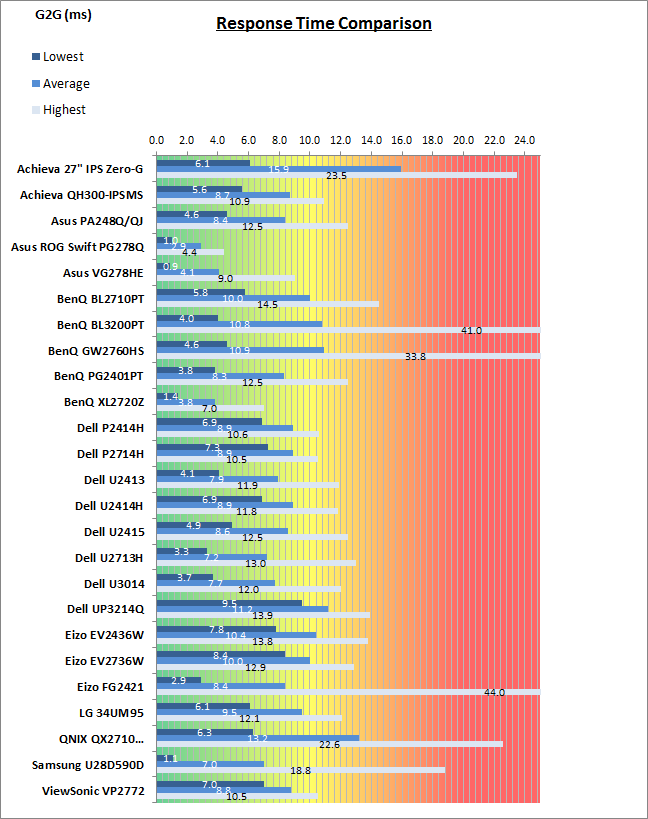
The above comparison table and graph shows you the
lowest, average and highest G2G response time measurement for each screen we
have tested with our oscilloscope system. There is also a colour coded mark next
to each screen in the table to indicate the RTC overshoot error, as the response
time figure alone doesn't tell the whole story.
The response time performance of the U2415 using
the 'Normal' Response Time setting was very good overall for an IPS-type panel. With an
average G2G response time of 8.6ms measured, it was even slightly faster than
the Dell P2414H and U2414H (8.9ms). Those models were our reference point before
and represented about as good as you can get from
modern IPS response times without introducing a significant amount of overshoot.
The Dell U2415 is slightly faster and also still free from any noticeable
overshoot which was very pleasing. The 'Fast' Response time mode pushed pixel
transitions faster, but did result in some significant overshoot so should
probably be avoided. Some IPS
models can reach lower response times, like the
Dell U2713H for instance (7.2ms)
but not without the cost of very high overshoot. Modern TN Film panels are still
much faster, reaching down to 2.9ms for instance in the example of the new
Asus
ROG Swift PG278Q (with moderate overshoot).
The screen was also tested using the chase test in
PixPerAn for the following display comparisons. As a reminder, a series of
pictures are taken on the highest shutter speed and compared, with the best case
example shown on the left, and worst case example on the right. This should only
be used as a rough guide to comparative responsiveness but is handy for a
comparison between different screens and technologies as well as a means to
compare those screens we tested before the introduction of our oscilloscope
method.

24"
8ms
G2G LG.Display AH-IPS (Response Time = Normal)
In practice the Dell U2415 performed best with
Response Time set to 'normal'. There were relatively low levels of motion blur
and no ghosting visible. Thankfully no overshoot was detectable at all which was
pleasing.

24"
8ms
G2G LG.Display AH-IPS (Response Time = Normal)

24" 8ms G2G
LG.Display e-IPS

23.8" 8ms G2G
LG.Display AH-IPS

23.8" 8ms G2G
LG.Display AH-IPS
We can first of all compare the performance of the
U2415 against 3 other 24" range screens from Dell. The U2415 is designed to
replace the old 2011 U2412M model and Dell have done a good job of clearing up
the overshoot issues associated with that old model. The U2412M shows some
noticeable dark trailing behind the moving image as you can see in the above
images, something which can be distracting during gaming and fast moving
content. Thankfully Dell have opted to give the user control over the overdrive
impulse on the new U2415 and so at the optimum 'normal' response time setting,
there is next to now overshoot at all. A definite improvement in pixel response
times and gaming performance there.
The U2414H and P2414H 16:9 models had impressed us
previously with their pixel transitions, offering response times as fast as you
can really get from a modern IPS panel without introducing any noticeable
overshoot. The U2415 performs almost identically in practice to the
U2414H/P2414H models which is very pleasing.

24"
8ms
G2G LG.Display AH-IPS (Response Time = Normal)

27"
1ms
G2G AU Optronics TN Film @ 144Hz (OD = Normal)

27" 1ms G2G
AU Optronics TN Film + 144Hz (AMA = High)

23.5" 4ms G2G
Sharp MVA + 120Hz
We've also included a comparison above against
3 very fast 120Hz+ compatible screens we have tested. The other screens shown
here are all aimed primarily at gamers and have various features and extras
which make them more suitable overall for gaming.
Firstly there is a comparison against the
Asus ROG Swift PG278Q with its 144Hz refresh
rate and fast response time TN Film panel. This showed very fast pixel response times and smooth movement thanks to
its increased refresh rate. You are able to reduce the motion blur even more
through the use of the ULMB strobed backlight as well if you need to. In other
related areas this screen also supports NVIDIA's G-sync technology. There was
some slight overshoot noticeable on the Asus but nothing major.
Then there is a comparison against the
BenQ XL2720Z with another very fast TN Film panel and 144Hz refresh rate.
This showed very low levels of motion blur, but some dark overshoot was
introduced as a side-effect as you can see. This screen even includes a native
Blur Reduction mode to help eliminate further perceived motion blur.
Lastly there is the MVA based Eizo FG2421 screen
with a fast response time (especially for the panel technology being used) and
120Hz refresh rate support. There is also an additional 'Turbo 240' motion blur
reduction mode which really helps reduce the perceived motion blur in practice.
While these pixel response tests from PixPerAn
give one view of the performance of the panel, there is something else going on as well here which can't be picked out by the camera. All of these other
gaming models are
running at 120Hz (or higher) refresh rates, which allows for improved 120fps+ frame rates and
in some cases the support of
3D stereoscopic content as well. This can really help improve smoothness and
the overall gaming experience so these screens still have the edge when it comes
to fast gaming. Any additional extras to reduce perceived motion blur can also
have a real benefit in practical terms, and again not easy to pick out with this
camera method.

The overall gaming performance of the Dell U2415
was very good and we were pleased with what Dell have done with the response
time control. This is the first time they've made a response time setting
available from the normal OSD and it's nice that they've not forced an overly
aggressive overdrive impulse on us like they did on some previous models (e.g.
U2413, U2713H). Instead, the two response time settings allow you to choose the
best option for your needs. The 'normal' mode was our preferred option, giving a
fast (for IPS) response time of 8.6ms G2G, without introducing any real
overshoot. A success really for this type of panel technology. It is a screen
lacking higher refresh rate support or any advanced gaming features like blur
reduction modes or G-sync, but as a general screen with decent IPS gaming
performance, it's impressive.

Additional Gaming Features

Aspect Ratio Control -
The U2415 has 3 options for
aspect ratio control through the OSD 'Display' menu as shown above. There are options for
16:10 (wide), 5:4 and 4:3 only. Disappointingly there is no option for 16:9
format which seems very odd given the massive adoption of that aspect ratio and
1920 x 1080 resolutions. There is no 1:1 pixel mapping mode either. This isn't a
problem really for PC gaming since you can let the graphics card handle the
scaling, but for connection of external devices, games consoles, Blu-ray players
etc, the lack of hardware aspect ratio control for 16:9 format content might be
a problem. If those are some of your desired uses, you would probably be better
going for the very similar, but 16:9 aspect ratio
U2414H model.

Preset Modes -
There is a specific 'game' available in the
OSD which appears to make the image a little cooler than our calibrated custom
mode. It gives you access to the dynamic contrast ratio control if you want to
use it as well.

Lag
We have written an in depth article about
input lag and the various measurement techniques which are used to evaluate
this aspect of a display. It's important to first of all understand the
different methods available and also what this lag means to you as an end-user.
Input Lag vs. Display Lag vs. Signal
Processing
To avoid confusion with different terminology we
will refer to this section of our reviews as just "lag" from now on, as there
are a few different aspects to consider, and different interpretations of the
term "input lag". We will consider the following points here as much as
possible. The overall "display lag" is the first, that being the delay between
the image being shown on the TFT display and that being shown on a CRT. This is
what many people will know as input lag and originally was the measure made to
explain why the image is a little behind when using a CRT. The older stopwatch
based methods were the common way to measure this in the past, but through
advanced studies have been shown to be quite inaccurate. As a result, more
advanced tools like SMTT provide a method to measure that delay between a TFT
and CRT while removing the inaccuracies of older stopwatch methods.
In reality that lag / delay is caused by a
combination of two things - the signal processing delay caused by the TFT
electronics / scaler, and the response time of the pixels themselves. Most
"input lag" measurements over the years have always been based on the overall
display lag (signal processing + response time) and indeed the SMTT tool is
based on this visual difference between a CRT and TFT and so measures the
overall display lag. In practice the signal processing is the element which
gives the feel of lag to the user, and the response time of course can
impact blurring, and overall image quality in moving scenes. As people become
more aware of lag as a possible issue, we are of course keen to try and
understand the split between the two as much as possible to give a complete
picture.
The signal processing element within that is quite
hard to identify without extremely high end equipment and very complicated
methods. In fact the studies by Thomas Thiemann which really kicked this whole
thing off were based on equipment worth >100,1000 Euro, requiring extremely high
bandwidths and very complicated methods to trigger the correct behaviour and
accurately measure the signal processing on its own. Other techniques which are
being used since are not conducted by Thomas (he is a freelance writer) or based
on this equipment or technique, and may also be subject to other errors or
inaccuracies based on our conversations with him since. It's very hard as a
result to produce a technique which will measure just the signal processing on
its own unfortunately. Many measurement techniques are also not explained and so
it is important to try and get a picture from various sources if possible to
make an informed judgement about a display overall.
For our tests we will continue to use the SMTT
tool to measure the overall "display lag". From there we can use our
oscilloscope system to measure the response time across a wide range of grey to
grey (G2G) transitions as recorded in our
response time
tests. Since SMTT will not include the full response time within its
measurements, after speaking with Thomas further about the situation we will
subtract half of the average G2G response time from the total display lag. This should allow us to give a good estimation of
how much of the overall lag is attributable to the signal processing element on
its own.
Lag Classification
To help in this section we will also introduce a broader classification system
for these results to help categorise each screen as one of the following levels:
-
Class 1)
Less than 16ms / 1 frame lag - should be fine for gamers, even at high levels
-
Class
2)
A lag of 16 -
32ms / One to two frames - moderate lag but should be fine for many gamers.
Caution advised for serious gaming and FPS
-
Class
3)
A lag of more
than 32ms / more than 2 frames - Some noticeable lag in daily usage, not
suitable for high end gaming
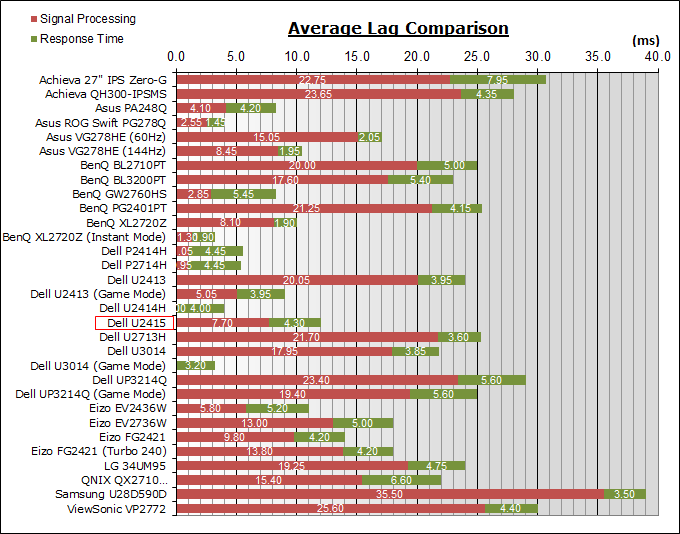
For the full reviews of the models compared here and the dates they were written
(and when screens were approximately released to the market), please see our
full
reviews index.
|
(Measurements in ms) |
|
|
Total Display Lag (SMTT
2) |
12.0 |
|
Pixel Response Time
Element |
4.3 |
|
Estimated Signal
Processing Lag |
7.7 |
|
Lag Classification |
1 |
|

Class
1 |
We have provided a comparison above against other
models we have tested to give an indication between screens. The screens
tested are split into two measurements which are
based on our overall display lag tests (using SMTT) and half the average G2G
response time, as measured by the oscilloscope. The response time is split from
the overall display lag and shown on the graph as the green bar. From there, the
signal processing (red bar) can be provided as a good estimation.
The screen showed a total average display lag of
12.0 ms as measured with SMTT 2. Taking into account half the average G2G
response time at 4.3ms ('Normal' Response Time setting), we can estimate that
there is ~7.7 ms of signal
processing lag on this screen. This is very low and should not present any problems
for gaming, even playing fast FPS games.

Movies and Video

The following summarises the screens performance
in video applications:
-
24"
screen size makes it a relatively small option for an all-in-one multimedia
screen, much smaller than LCD TV's nowadays.
-
16:10
aspect ratio is not as well suited to videos and movies as 16:9 format
models, leaving
you with larger borders on DVD's and wide screen content at the top and
bottom.
-
1920 x
1200 resolution can support full 1080 HD resolution content.
-
Digital interfaces support HDCP for any encrypted and protected content
-
HDMI and DisplayPort
connections available. Nice to see HDMI connectivity included for modern DVD
players, Blu-ray, consoles etc. 2 HDMI ports are available on this model. MHL
support if you want to play content mirrored from your mobile devices.
-
Cables provided in the box
for DisplayPort to Mini DisplayPort only, no HDMI cable is provided.
-
Light
AG coating provides clear images with no major graininess, and without the
unwanted reflections of a glossy solution.
-
Wide
brightness range adjustment possible from the display, including high maximum
luminance of ~335
cd/m2 and a good minimum luminance of
27 cd/m2. This should afford you very good control for different
lighting conditions. Contrast ratio remains stable across most of that adjustment
range as well and is very good for an IPS-type panel. Brightness regulation is controlled
without the need for PWM and so is flicker free at all settings which is
pleasing.
-
Black
depth and contrast ratio are very good for an IPS-type panel at 1011:1 after
calibration. Detail in darker scenes should not be lost as a result.
-
There
is a specific 'movie' preset mode available for movies or video in the OSD
which looked a lot cooler and more blue than our calibrated custom mode.
-
Good
pixel responsiveness which can handle fast moving scenes in movies without
issue. No overshoot issues when sticking to the 'normal' response time mode
which is great news.
-
Wide viewing angles from IPS panel technology
meaning several people could view the screen at once comfortable and from a
whole host of different angles. White glow from an angle on black content may
be problematic to some users.
-
Some
slight areas of backlight leakage but nothing major on our sample which is
good. Some uniformity variations may be visible on darker movie scenes in
darkened room conditions.
-
Wide range of ergonomic adjustments available
from the stand, allowing you to adjust the screen to suit varying viewing
positions. The side to side swivel is too stiff which might be a bit of a pain
for viewing movies from a non desk position.
-
No integrated stereo speakers offered on this model, but it is compatible with
Dell's SoundBar if you want. There is also an audio out connection if you want
to connect to headphones or separate speakers when sending sound to the screen
over HDMI.
-
Hardware aspect ratio control options are limited, and missing 16:9 or 1:1
pixel mapping options. Might be a pain if using external devices to pay
movies, but not an issue from a PC of course. Should have included a 16:9 mode
really.
-
Picture By Picture (PbP) or Picture In Picture (PiP) are not available on
this model.

Conclusion
We had high hopes for the U2415 display after
recent Dell models like the P2414H and U2414H had impressed us with their solid
all round performance. Thankfully it didn't disappoint. The U2415 is for all
intents and purposes a 16:10 version of the U2414H. There's one extra USB port
here, but apart from that the connections and functionality are the same. Both
offer the new slim bezel design which looks very attractive and is ideal for
multi-screen setups. The U2415 had a wider range of backlight adjustments and a
slightly higher static contrast ratio than the U2414H although it shouldn't make
much real difference. We were impressed by the high contrast ratio here on the
U2415 which is about as good as you can hope for from an IPS-type panel at the
moment. The factory calibration on both models offered a decent enough setup for
most users, being slightly more accurate on the U2414H. Both models offered
good uniformity and no noticeable backlight bleed which was encouraging. Both
featured the latest light AG coating and PWM-free backlights which was a
positive step forward as well. Response times were as good as you can get from
modern IPS-type panels as well, without introducing any significant overshoot,
and input lag was very low on both models.

The all-round performance, features, specs and
extras of both the U2414H and U2415 were impressive, so you can really choose
based on whether you want a 16:10 aspect ratio screen or a 16:9 aspect ratio.
The former is arguably a little better for office work and general desktop use,
but the lack of a 16:9 scaling option means it is not really suited if you want
to connect external devices for multimedia at all. The U2414H is a better option
if you want to use external devices, or just prefer smaller/non-existent borders
for your movies, films and games and those are more of a focus for you than
general office work.
The U2415 made a very nice update to the U2412M as
well. There's more modern connectivity options including HDMI offered, the new
slim bezel design, USB 3.0 support, factory calibration and touch sensitive
buttons on the new model. Dell have also moved to the light AG coating instead
of the grainy old coating on the U2412M, and also used a flicker free backlight
this time which is great news. Default setup is better on the U2415 thanks to
the factory calibration, and Dell have also improved response times and
eliminated the noticeable overshoot seen on the older model. All in all this is
a better screen than the U2412M and if you're looking for a 16:10 aspect ratio
24" model this is a great all-round performer.
If you appreciate the review
and enjoy reading and like our work, we would welcome a
donation
to the site to help us continue to make quality and detailed reviews for you.
|
Pros |
Cons |
|
Good factory calibration and
great all-round performance |
Missing DVI and VGA
connections, may be limited for some |
|
Flicker free backlight and
light AG coating on new model |
Lack of 16:9 aspect ratio
option problematic for external multimedia devices potentially |
|
Decent responsiveness and very
low lag for gaming |
More IPS glow than the U2414H
panel |
|
Check Pricing and Buy - Direct Links
|
|
Amazon
|
|
TFTCentral is a participant
in the Amazon Services LLC Associates Programme, an affiliate
advertising programme designed to provide a means for sites to earn
advertising fees by advertising and linking to Amazon.com, Amazon.co.uk,
Amazon.de, Amazon.ca and other Amazon stores worldwide. We also
participate in a similar scheme for Overclockers.co.uk. |
|
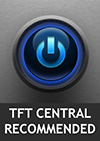
|
TFT Central Awards Explained
We have two award
classifications as part of our reviews. There's the top 'Recommended'
award, where a monitor is excellent and highly recommended by us. There is
also an 'Approved' award for a very good screen which may not be perfect,
but is still a very good display. These awards won't be given out every
time, but look out for the logo at the bottom of the conclusion. A list of
monitors which have won our awards is available
here. |

